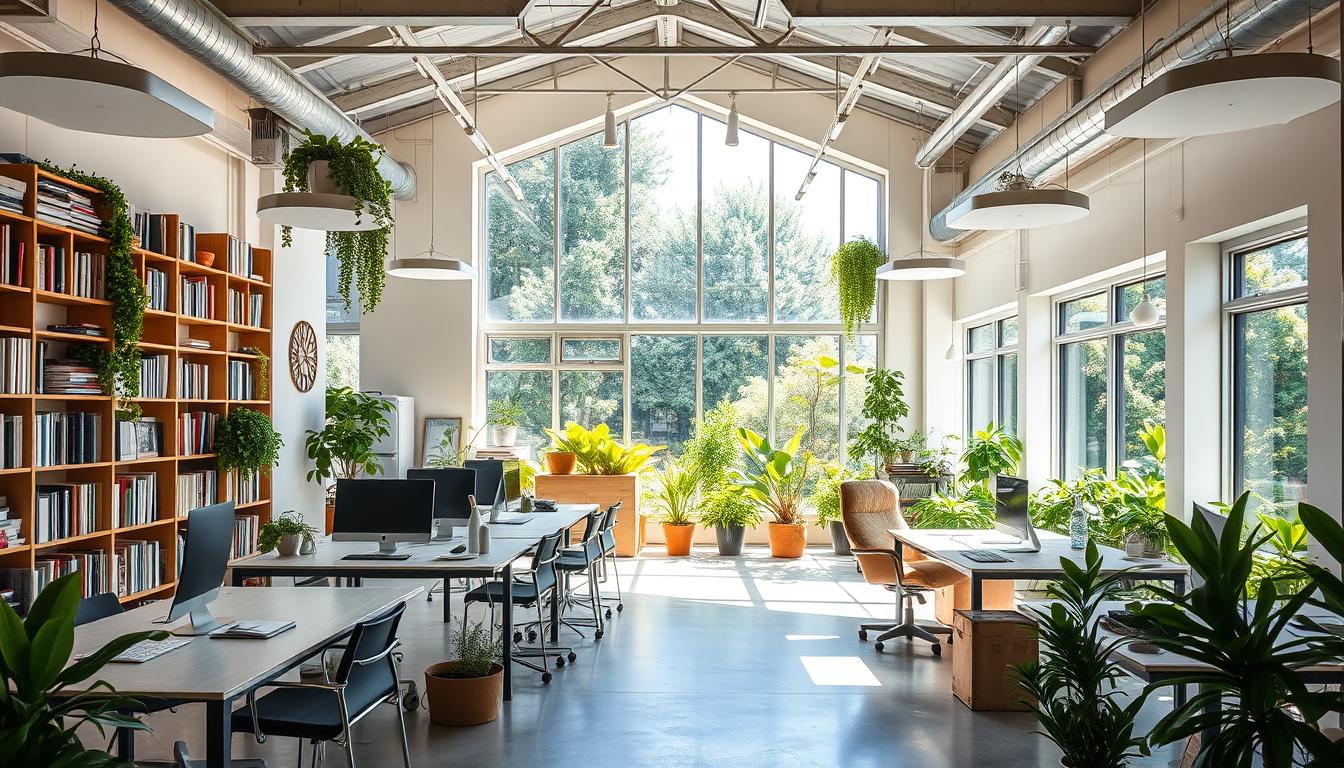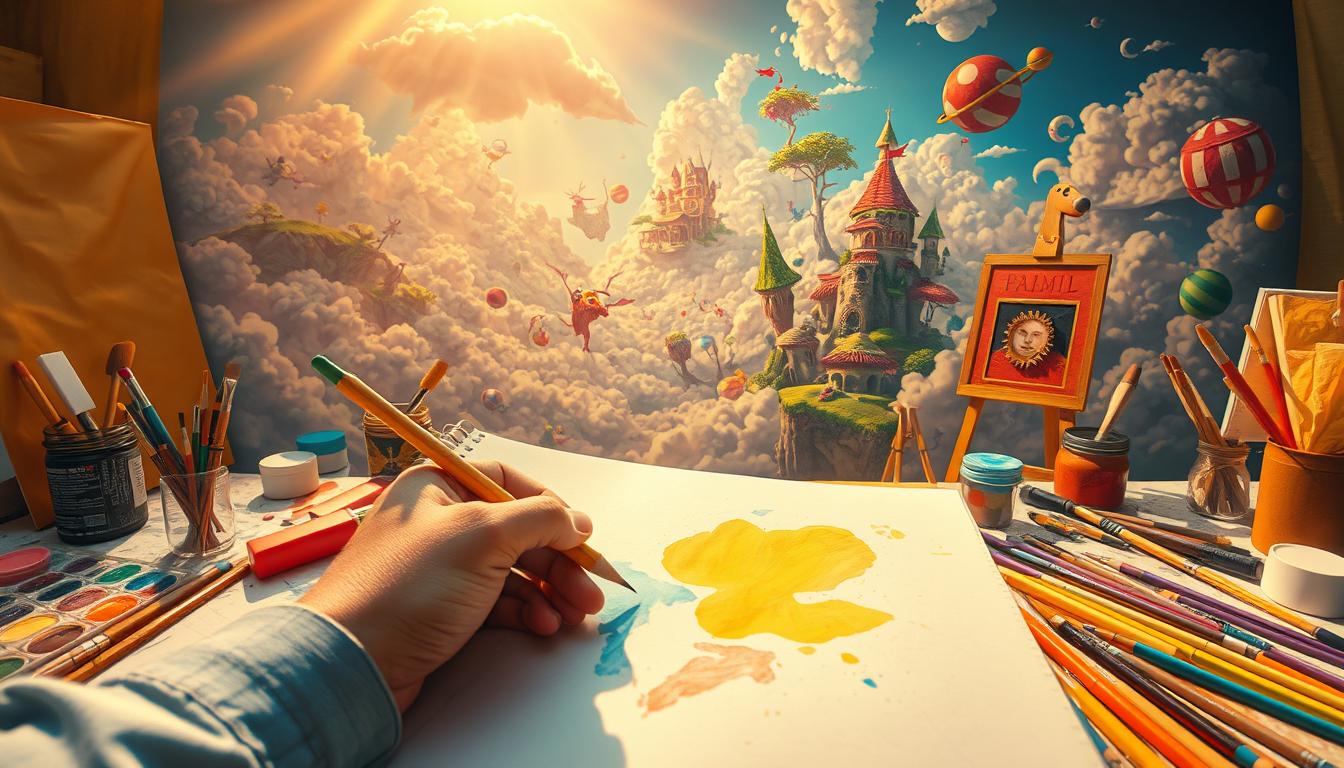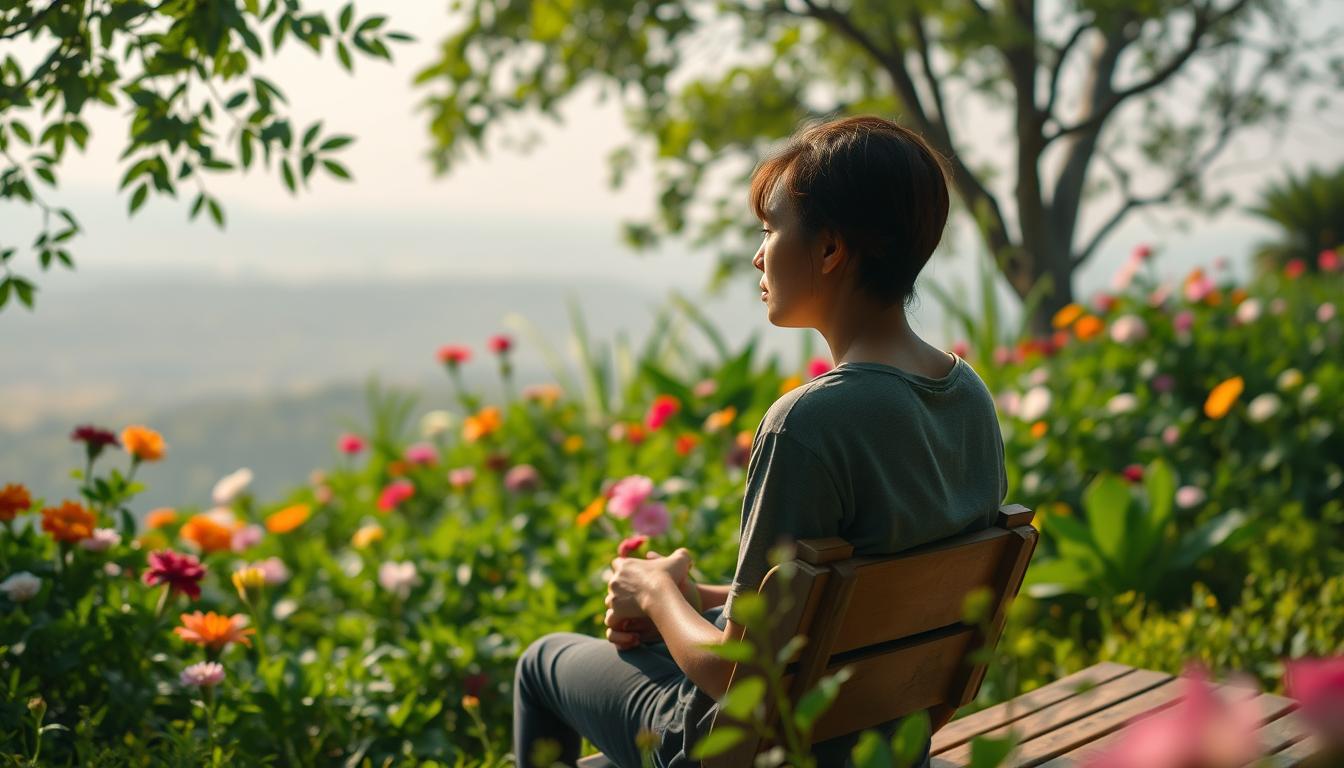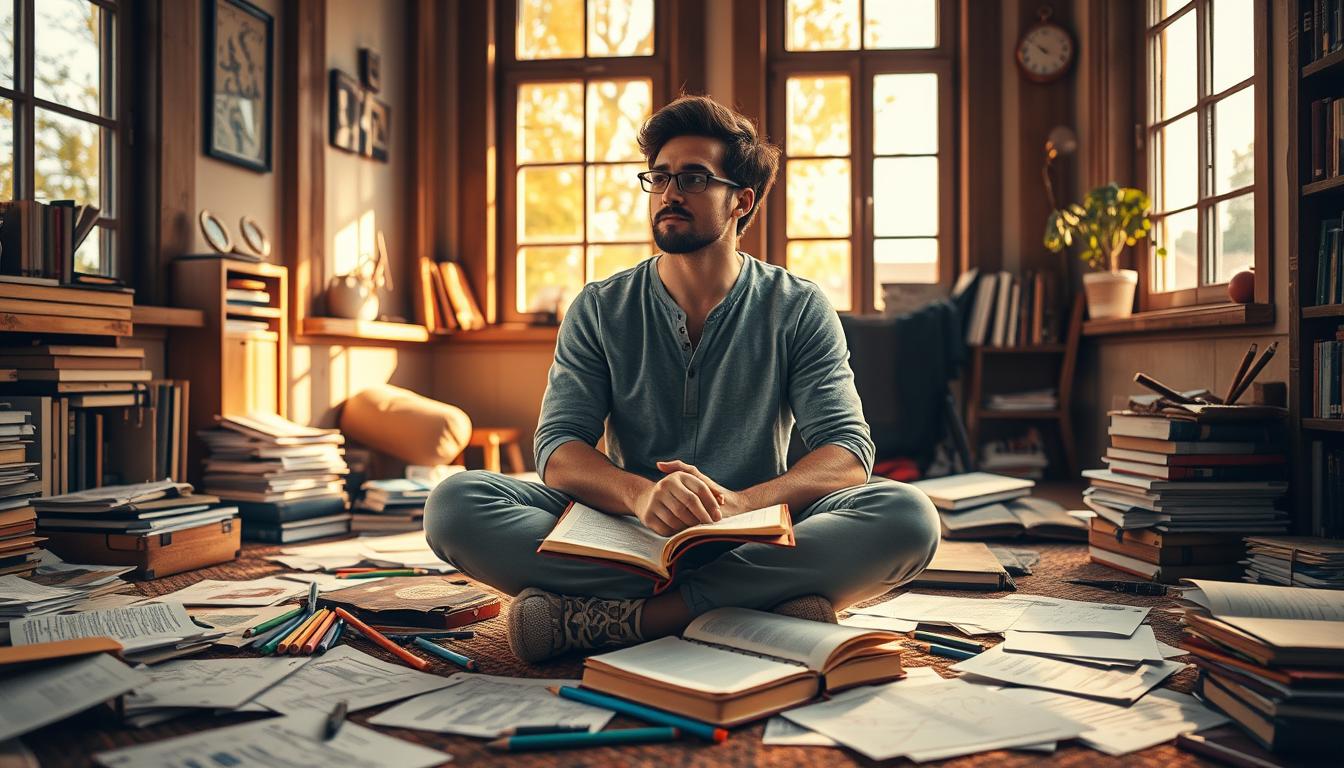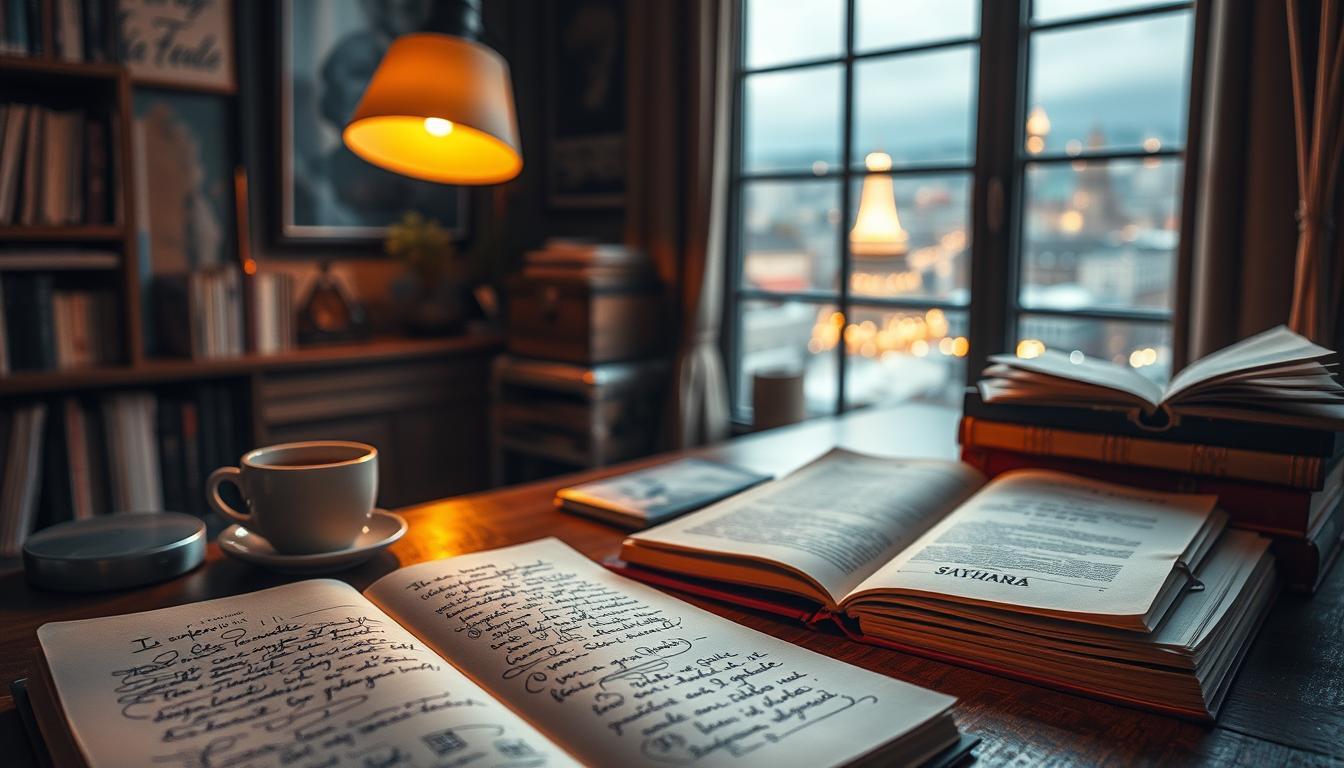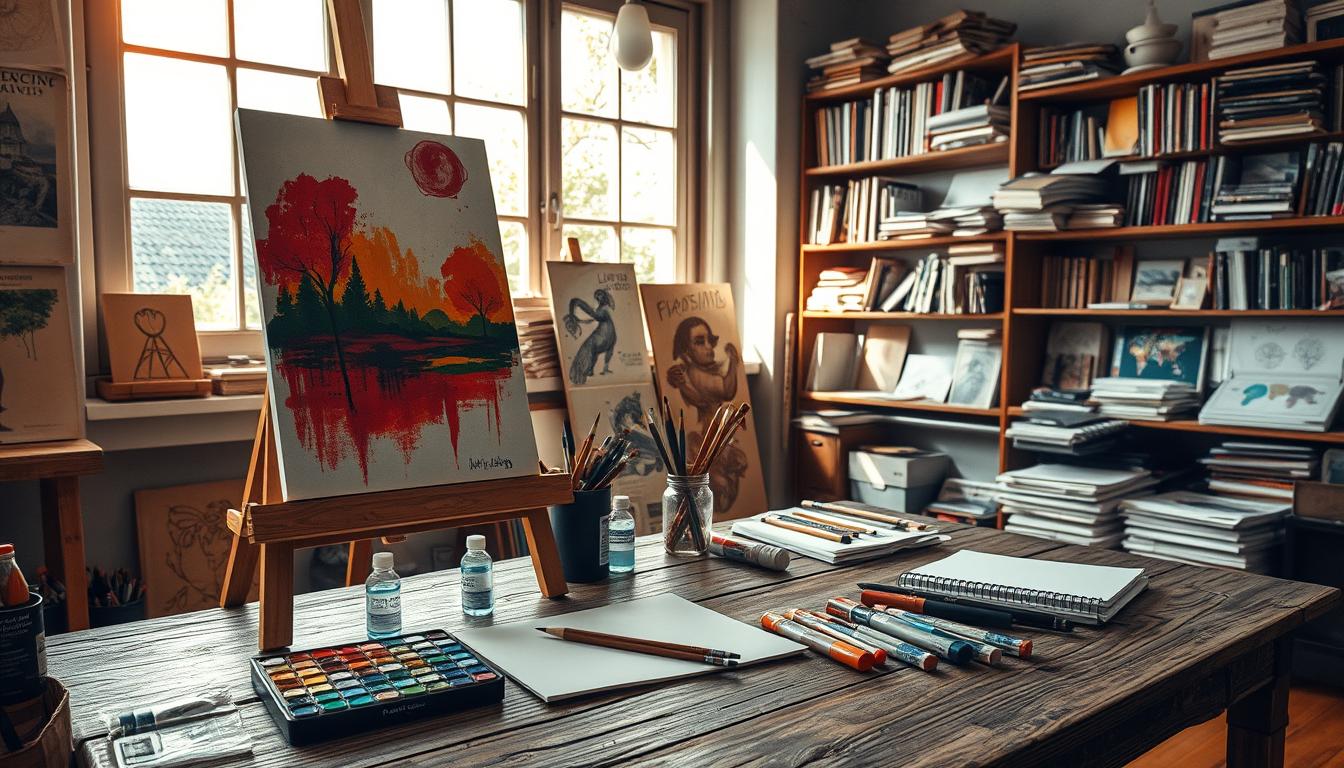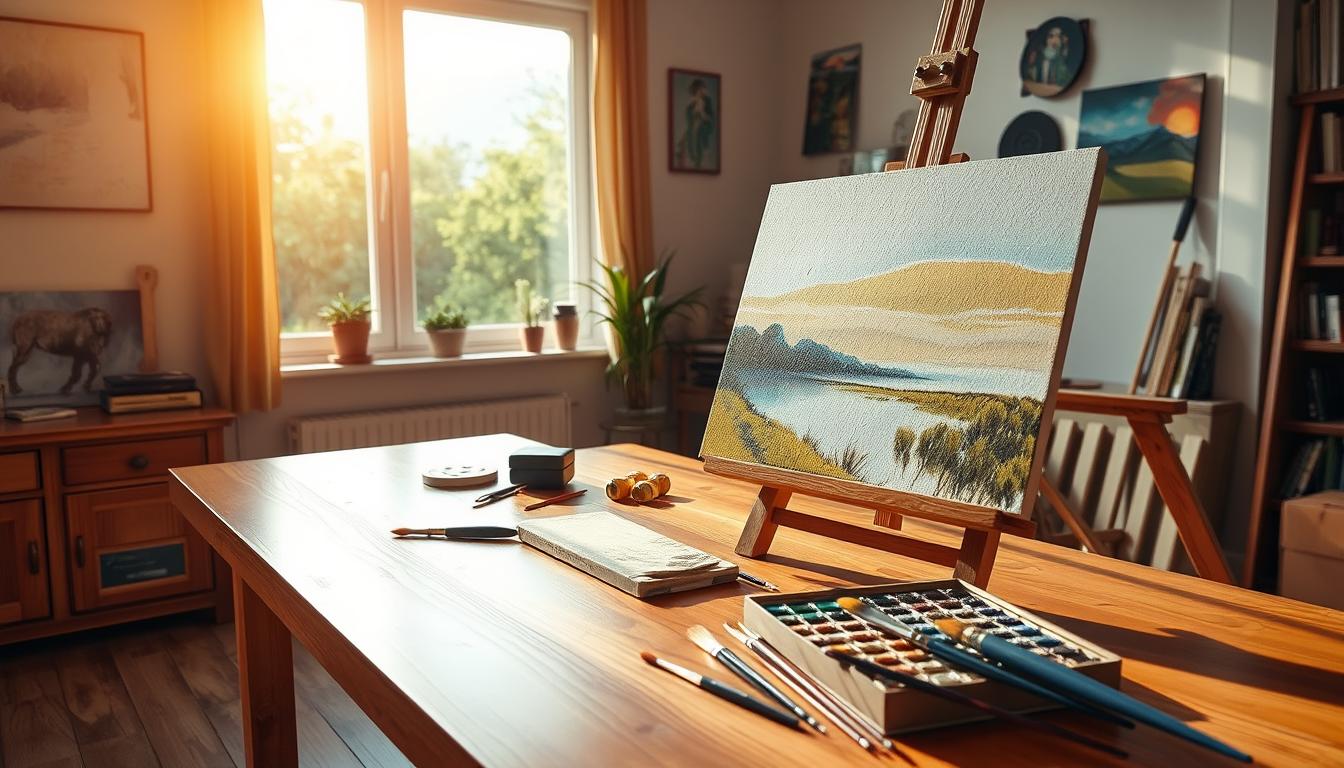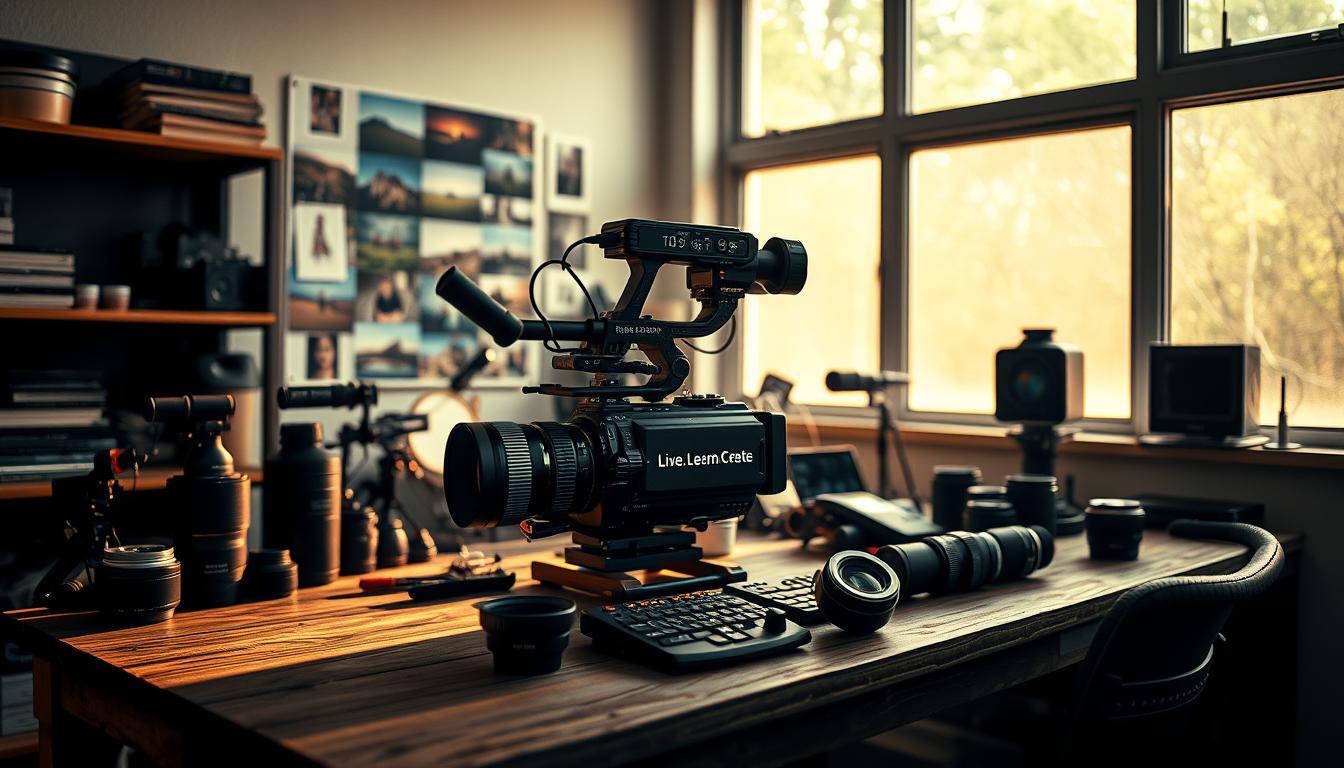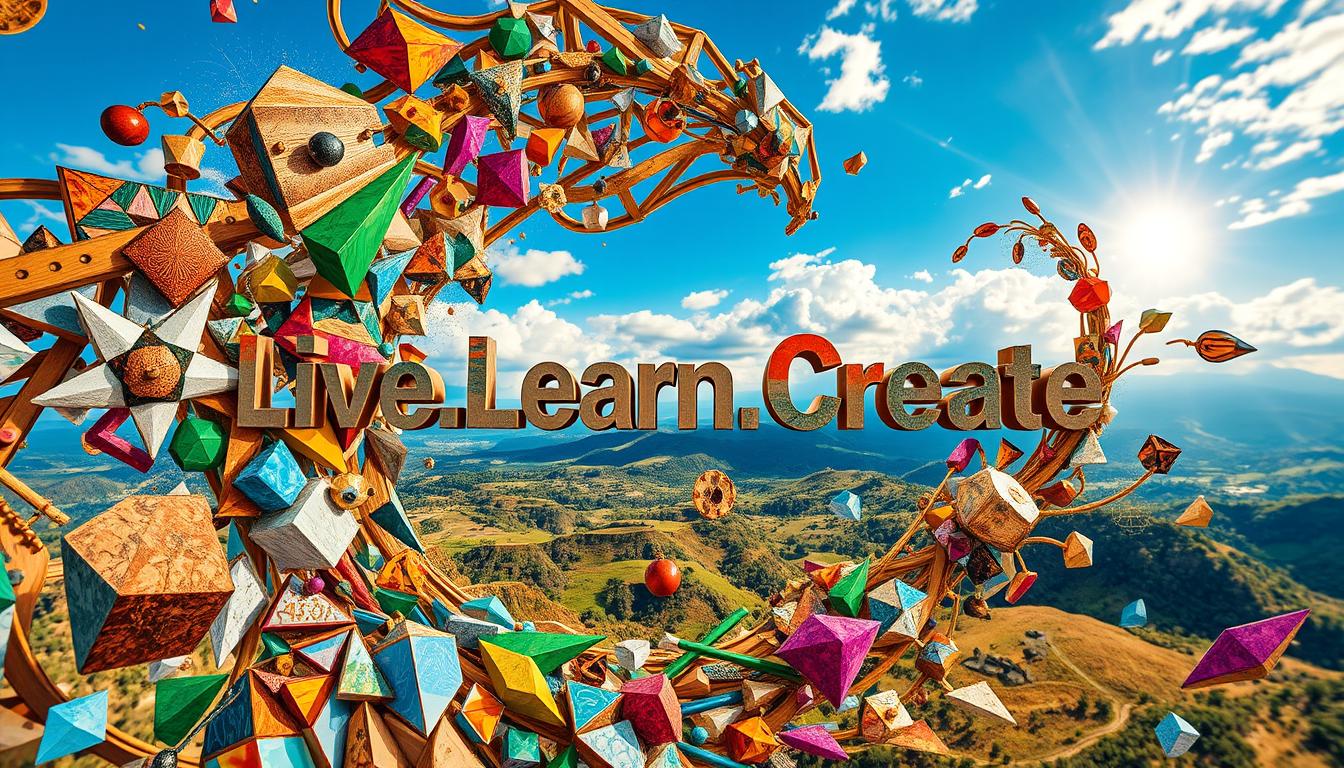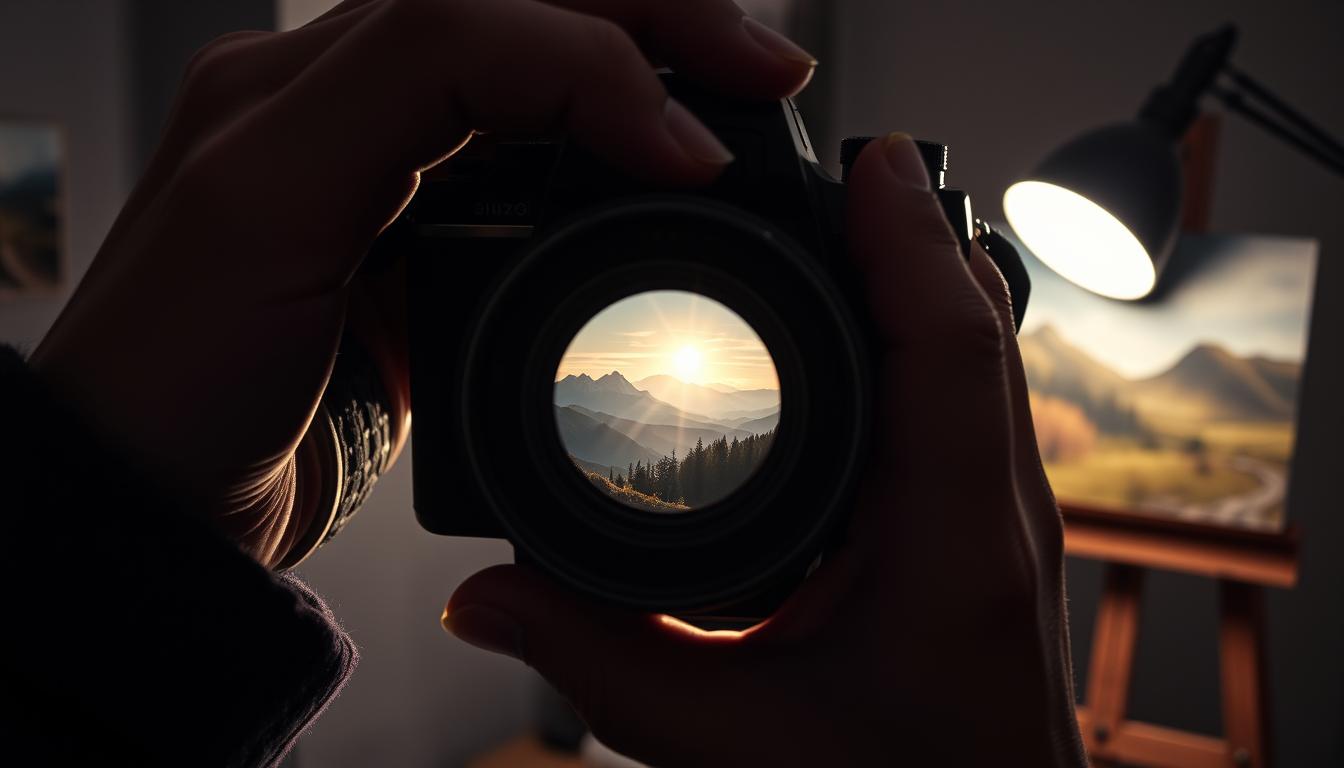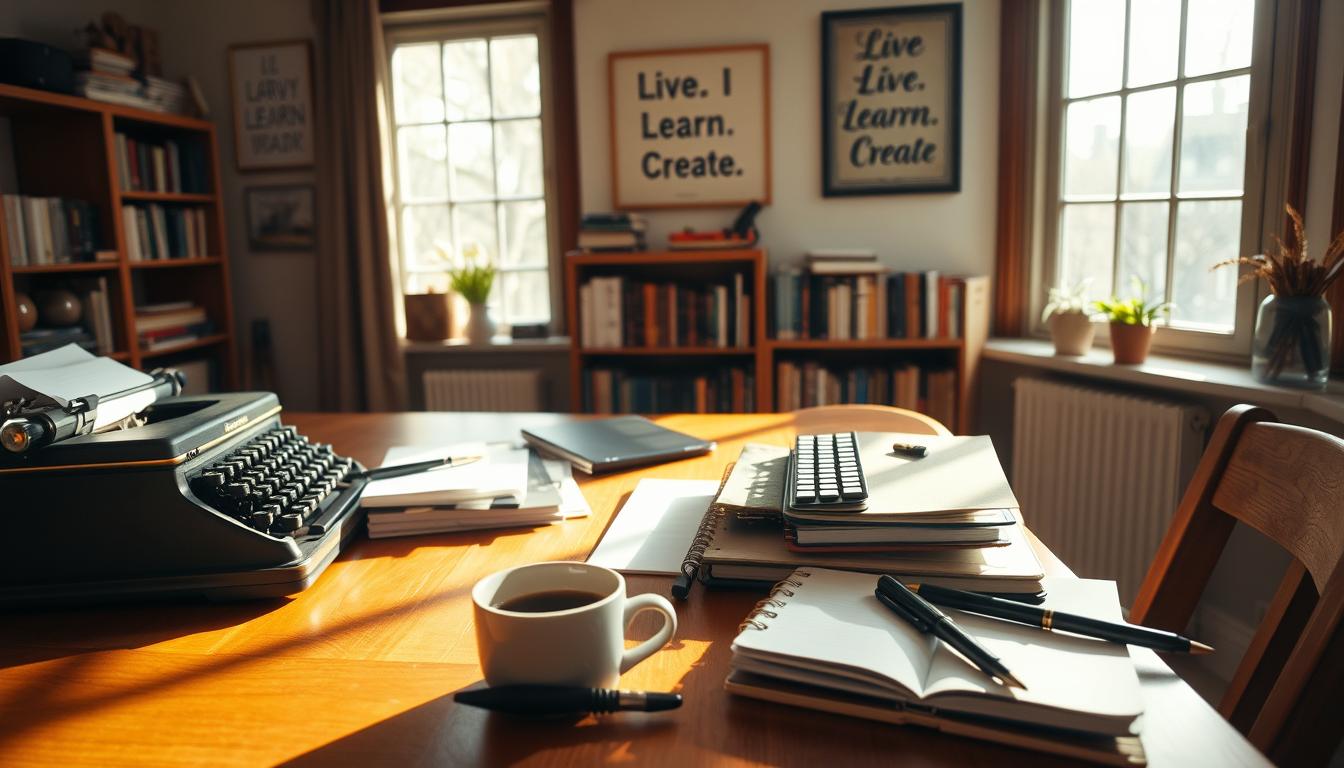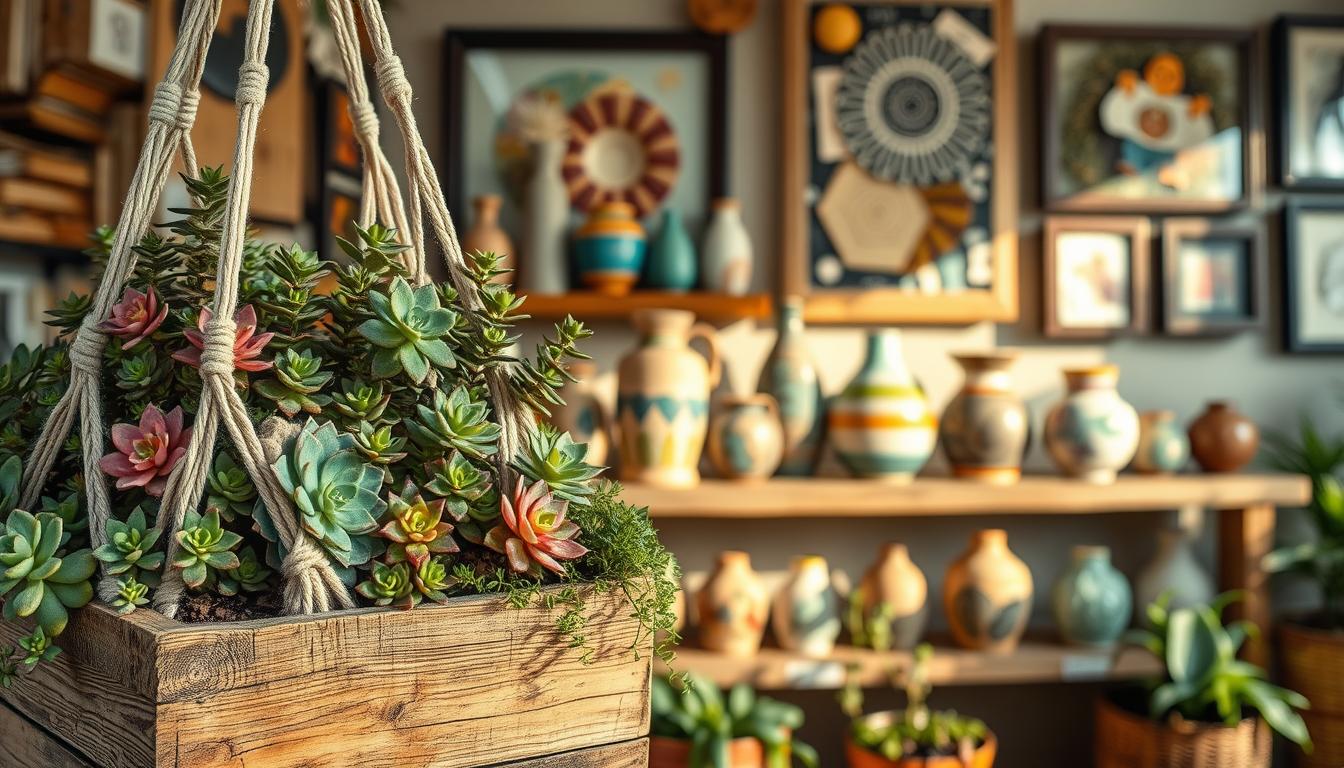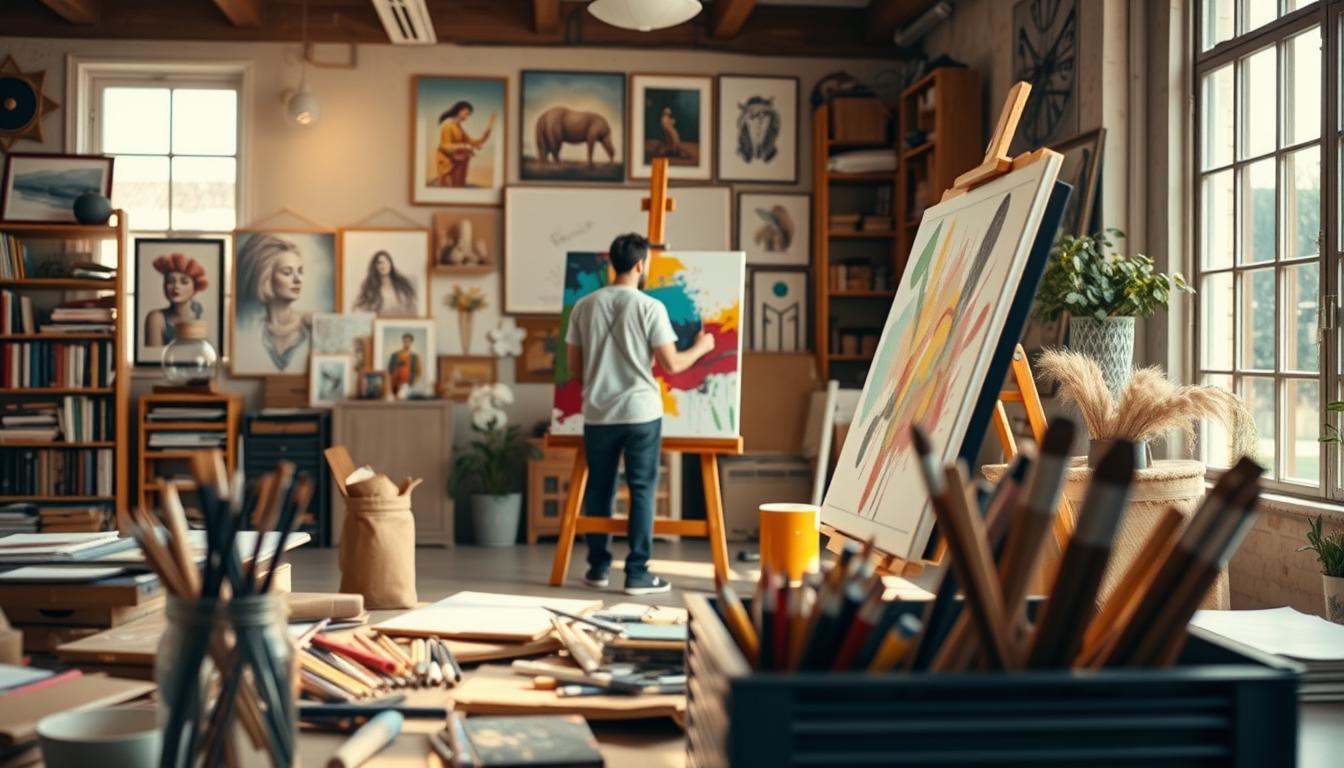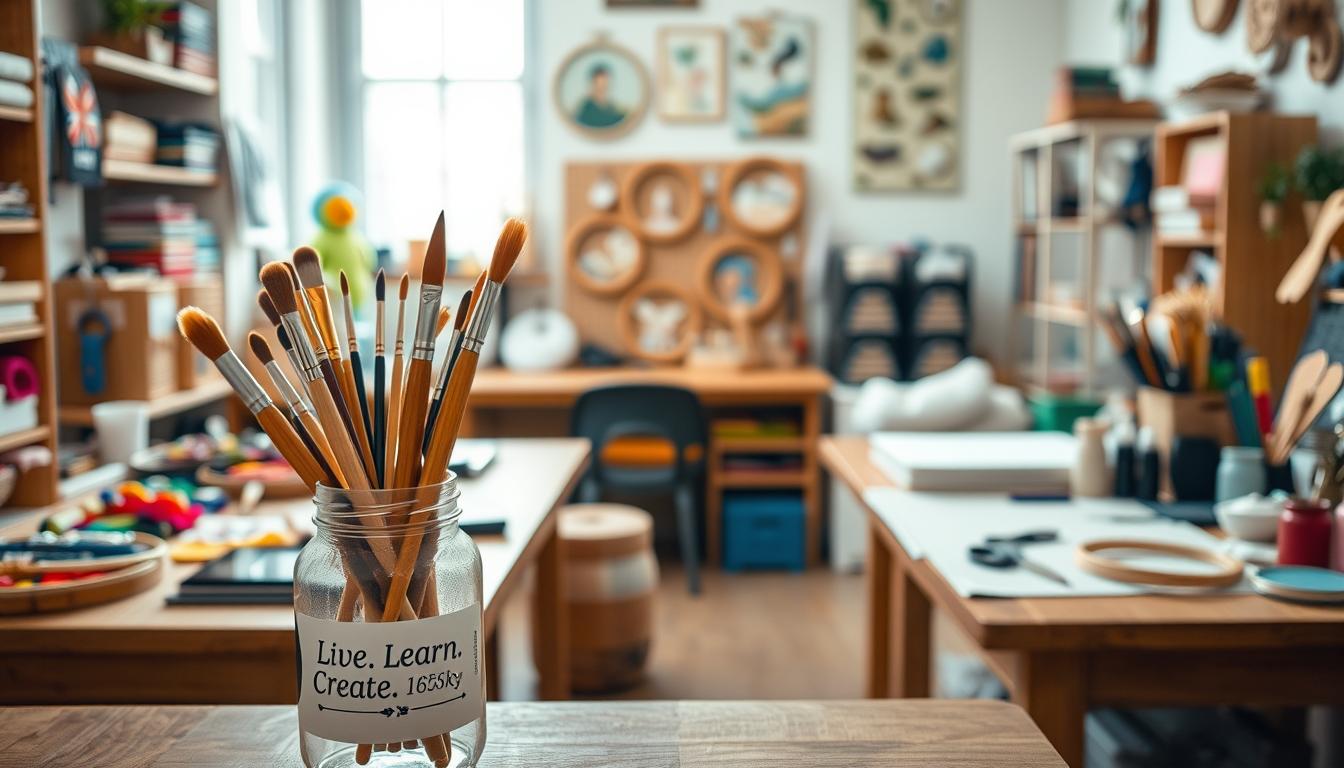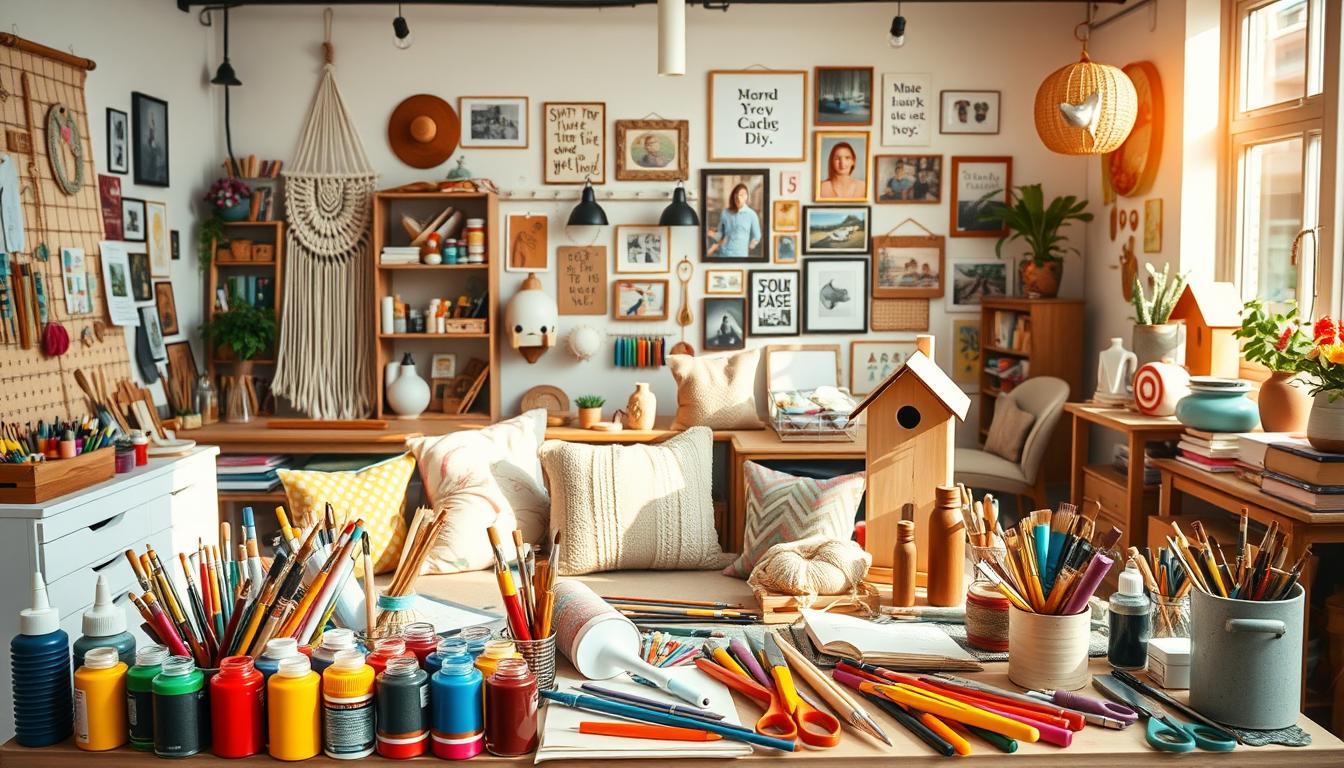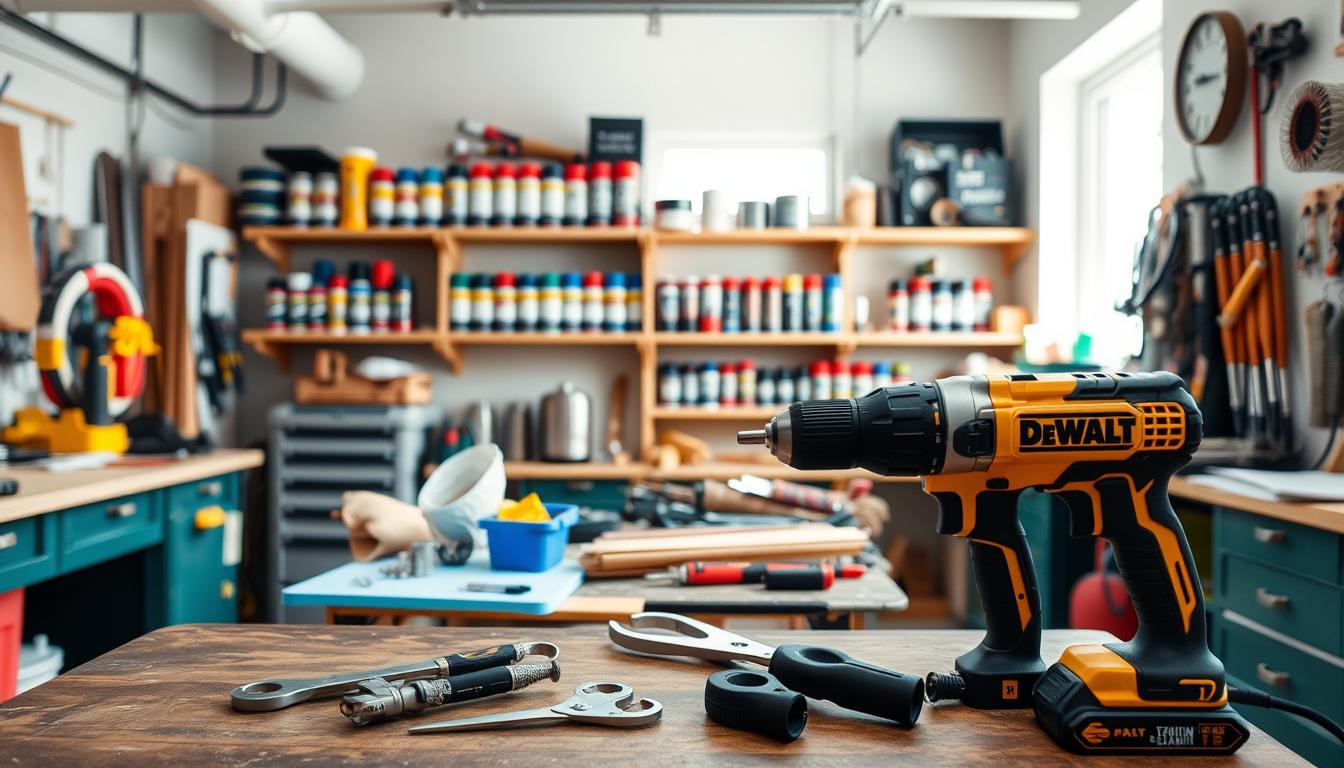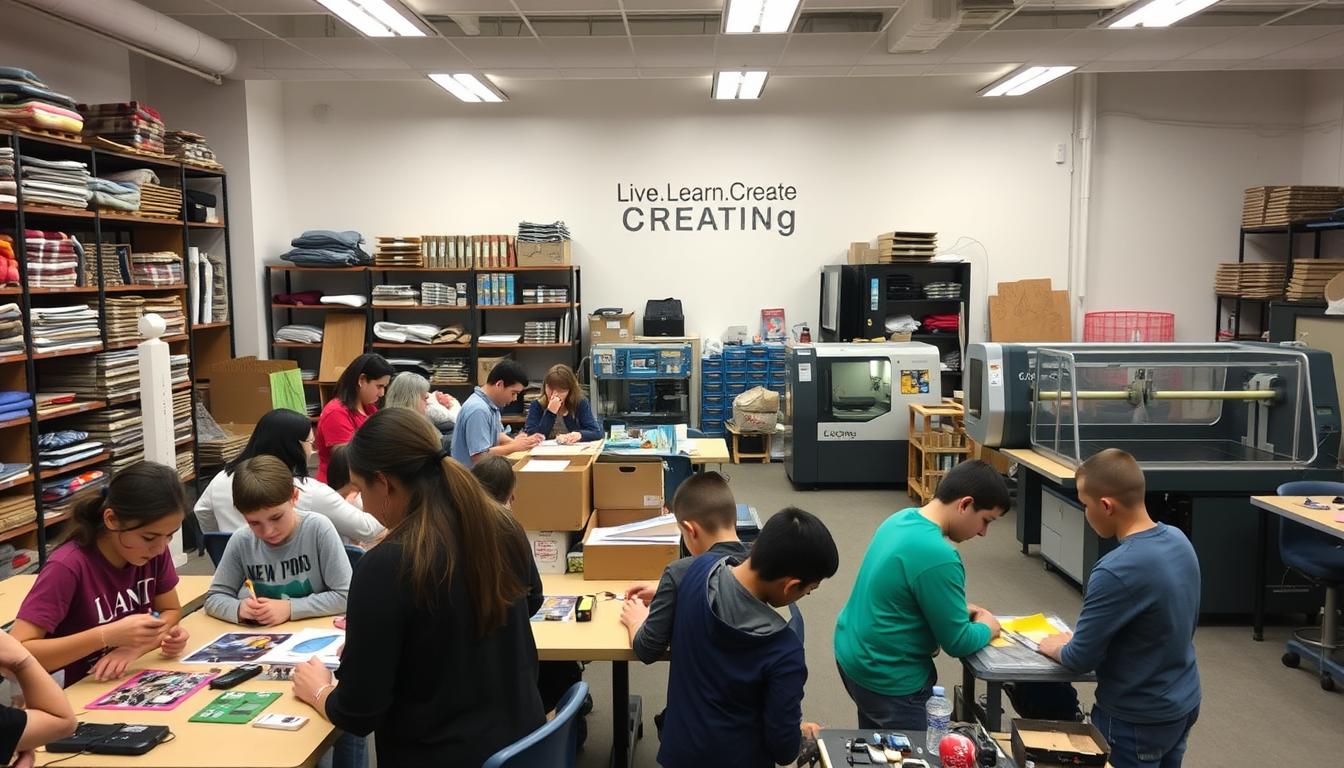“You can’t use up creativity. The more you use, the more you have.” – Maya Angelou. This inspiring quote shows how vital it is to nurture our imagination.
Our surroundings greatly affect our ability to think creatively and stay productive. By creating a space that encourages imagination and well-being, we can reach our full capacity and meet our goals.
As we dive into making a supportive environment, we’ll find useful tips and insights. These will help us create a space that boosts innovative thinking and supports our best habits.
Key Takeaways
- Create a clutter-free space to enhance focus and imagination.
- Incorporate elements of nature to boost innovative thinking.
- Use lighting and color schemes to stimulate creativity.
- Invest in ergonomic furniture for comfort and productivity.
- Minimize distractions to maintain productive habits.
Understanding the Importance of Creativity
In a world that values originality, knowing about creativity is key to reaching our full ability. As we face the challenges of today, creativity is a powerful tool for new ideas and growth.
What is Creativity?
Creativity is about making new and useful ideas through imagination and innovation. It’s about ideation, creating new concepts, and solving problems in new ways. This skill is not just for artists but is important in many areas of life.
Understanding creativity helps us see its value in our everyday lives and personal growth.
Why Creativity Matters in Daily Life
Creativity is important because it lets us see problems in new ways, leading to creative problem solving. It helps us innovate, adapt, and grow in a changing world. Creativity opens up new chances and solutions in our personal and work lives.
By embracing creativity, we can innovate and make a difference in our fields. It’s about creating a space that supports our best habits and encourages new ideas and progress.
Identifying Your Creative Goals
The first step to boost your creativity is to set clear, meaningful goals. These goals should match your dreams and values. This way, you focus your creative energy on outcomes that are both rewarding and true to you.
Setting Specific Objectives
Creating effective goals means making them specific and measurable. Use design thinking to understand your creative needs. Define the problem and come up with solutions. For example, instead of saying “I want to be more creative,” say “I aim to spend 30 minutes daily brainstorming for my next art project.”
Exploring new ideas can also help set unique goals. Try different mediums or techniques, like digital painting if you’re used to watercolors. Or, mix media in your work.
Aligning Goals with Your Passions
Linking your creative goals with your passions keeps you motivated and joyful. Think about what excites you most about creativity—is it creating something new, expressing yourself, or sharing your work? Knowing your motivations helps tailor your goals to boost your artistic expression.
Here’s a simple way to align your goals with your passions:
| Passion Area | Creative Goal | Action Steps |
|---|---|---|
| Artistic Expression | Improve painting skills | Take weekly painting classes, practice for 1 hour daily |
| Creative Writing | Write a short story | Dedicate 30 minutes each morning to writing, join a writing group |
| Design | Learn graphic design | Enroll in an online course, work on projects weekly |
By using this framework and checking your progress often, you can make sure your goals match your passions. They should also be achievable and meaningful.
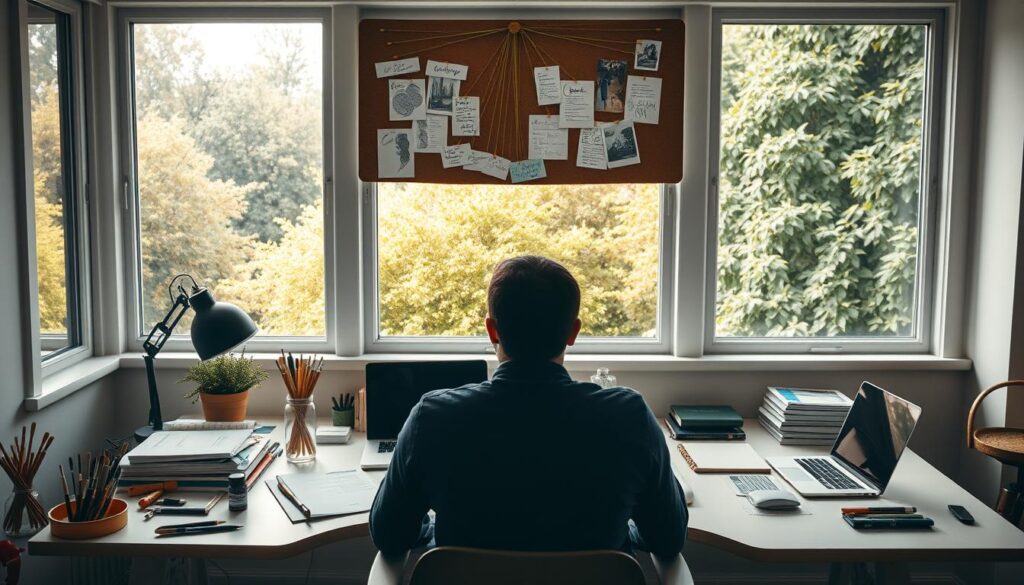
The Role of Environment in Fostering Creativity
The space around us greatly affects our creativity and innovative thinking. Our daily environment can either block or boost our imagination.
A well-designed space can deeply impact our creative thinking. By adding elements that inspire us, we can discover new ideas and ways to solve problems.
Elements of a Creative Space
A creative space is more than a place; it’s a world that feeds our imagination. Key elements include:
- Comfortable seating and ergonomic furniture
- Inspirational art and decor
- Access to natural light
- A clutter-free environment
Natural Light and Its Effects
Natural light greatly affects our mood and work efficiency. It can increase our energy, sharpen our focus, and improve our overall happiness. Use light therapy lamps in winter or dim spaces to keep the light steady.
Adding items like ergonomic furniture and light therapy lamps from Amazon can enhance your creative space. They help create an environment that supports your creativity and good habits.
Organizing for Inspiration
An organized workspace is key for staying focused and sparking new ideas. By clearing our space and using good organization, we can avoid distractions and stay inspired. Use storage and sort your materials to keep your area neat and productive.
Creating a space that encourages creativity can boost our imagination and open up new ideas. Whether it’s through natural light, ergonomic furniture, or inspiring decor, our surroundings are vital in unlocking our creative abilities.
Decluttering for Creativity
Unlocking our full creative power begins with a simple step: decluttering. Clearing our space and mind lets us focus and think better.
The Benefits of a Clean Slate
A clutter-free area boosts our creative thinking. Here’s why:
- Reduced Stress: Clutter causes stress, which blocks our creative flow.
- Improved Focus: A tidy space helps us focus, leading to creative problem solving and originality.
- Enhanced Imagination: A clear mind and space spark new ideas and ideation.
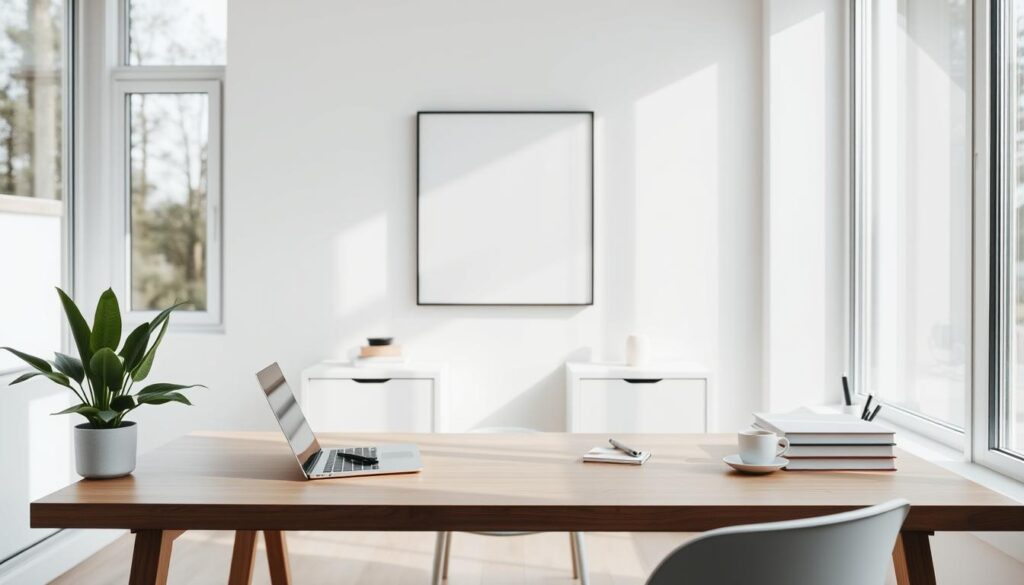
Tips for Effective Decluttering
Here are some decluttering tips:
- Start Small: Tackle one area or task at a time to stay focused.
- Sort and Purge: Organize items into categories, keeping only what’s essential or joyful.
- Organize What’s Left: Use storage to keep things tidy and easy to find.
- Maintain the Space: Set regular decluttering times to keep your space organized.
Following these tips will not only organize your space but also support your creativity.
Creating a Comfortable Workspace
To foster artistic expression, you need a welcoming and ergonomic workspace. A well-designed space boosts your creativity and productivity.
Ergonomics and Creativity
An ergonomic workspace boosts your creative thinking. An ergonomic chair and a standing desk keep you energized and focused. For example, ergonomic chairs on Amazon support you during long hours. Standing desks help you stay active by switching between sitting and standing.
Buying ergonomic furniture boosts your creative power. It lets you work longer without getting tired. This way, you can dive into design thinking and come up with out-of-the-box ideas.
Incorporating Personal Touches
Adding personal touches to your workspace inspires you. This could be family photos, artwork, or quotes. These elements spark your creativity and make your space feel welcoming.
Display items that show your personality or interests. This makes your workspace fun and sparks creativity. It surrounds you with things you love.
By mixing ergonomics with personal touches, you create a space that’s both comfy and creative. This balanced approach supports your well-being. It fosters an environment where artistic expression can thrive.
Bringing Nature Indoors
Embracing biophilic design can turn our workspaces into creativity havens. By adding nature elements, we boost our imagination and encourage new ideas.
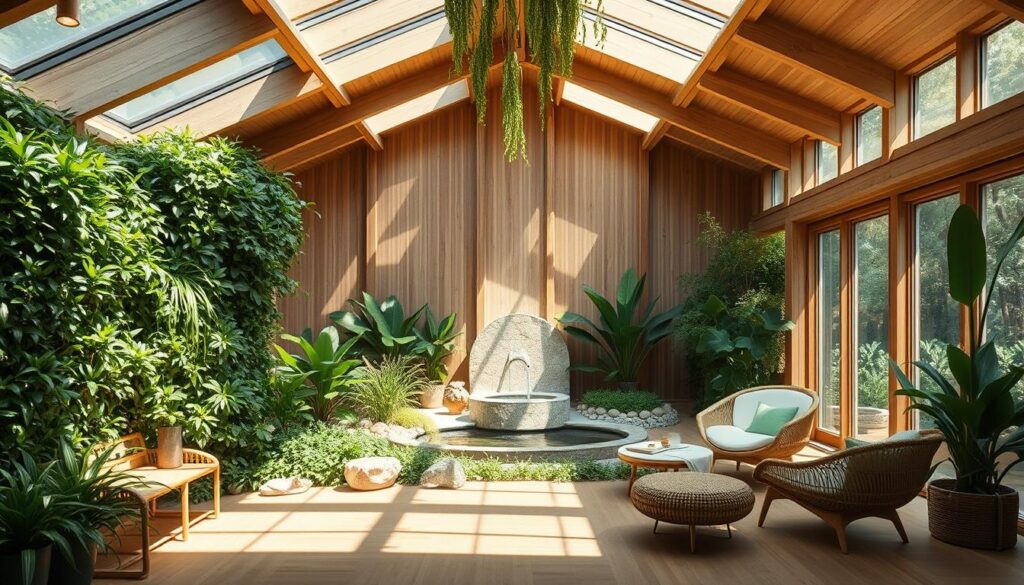
The Biophilic Design Principle
Biophilic design connects us with nature through architecture and interior design. It shows that being near nature improves our well-being and work performance. By bringing nature inside, we make our spaces calmer and more inspiring, boosting our creativity.
Key biophilic design elements include natural materials like wood and stone. Adding plants and green walls is also important. Using natural light and elements that reflect nature, like artwork or colors, also enhances a space’s biophilic design.
Plants That Boost Creativity
Some plants can positively affect our creativity and mood. For instance, snake plants and spider plants are easy to care for and clean the air. They also create a peaceful atmosphere. Peace lilies and dracaena help reduce stress and improve well-being.
For your workspace, start with easy-to-care-for plants like succulents or air plants. You can find stylish planters on Amazon to add natural beauty. The Lechuza Classico Self-Watering Planter and the Modern Planters Trio Set are popular choices.
Utilizing Technology for Creative Flow
Technology opens up new ways to express ourselves creatively and work more efficiently. It’s a key part of our creative journey. It offers many tools to boost our imagination and make our workflow smoother.
Digital Tools and Resources
Digital tools are vital for originality and ideation in creativity. There are many options, like mind mapping software and digital painting apps. For example, MindMeister for mind maps, Adobe Fresco for digital art, and Trello for managing projects can improve our creativity.
These tools help us come up with ideas and organize them well. They make our creative process more productive and imaginative.
Setting Up Creative Software
Getting creative software ready is important for working well. It’s not just about installing it. We need to customize it to fit our needs. This means tweaking the interface, setting shortcuts, and adding plugins.
It’s also key to keep up with the latest versions and features. Many software providers offer tutorials and workshops. By learning these tools, we can improve our creative problem-solving skills.
In summary, technology is a great help in our creative work. By using the right digital tools and setting them up right, we can improve our creative flow and reach our goals better.
Scheduling Time for Creative Activities
To unlock your full creative power, it’s key to set aside time for artistic expression. In today’s fast-paced world, creativity can easily get pushed aside. Yet, making it a priority can greatly boost personal growth and innovation.
By committing time to creative activities, you can spark out-of-the-box ideas and see things from new angles. This can make your life more rewarding and give you a clearer sense of purpose.
The Pomodoro Technique
The Pomodoro Technique is a great way to manage your creative time. It involves working in focused, 25-minute blocks, followed by a 5-minute break. After four cycles, take a longer break of 15-30 minutes.
- Choose a creative task you want to tackle.
- Set a timer for 25 minutes and focus on the task without distractions.
- Take a 5-minute break to relax and recharge.
- Repeat the cycle for a total of four “Pomodoros.”
- Take a longer break to rest and reflect on your progress.
Establishing a Routine
Creating a routine can keep you on track with your creative projects. By making creativity a regular part of your day, it becomes a lasting part of your life.
Here are some tips for setting up a creative routine:
- Find a time of day that works best for your creative activities.
- Set up an environment that encourages design thinking and sparks inspiration.
- Begin with short, achievable sessions and gradually increase time as you get more comfortable.
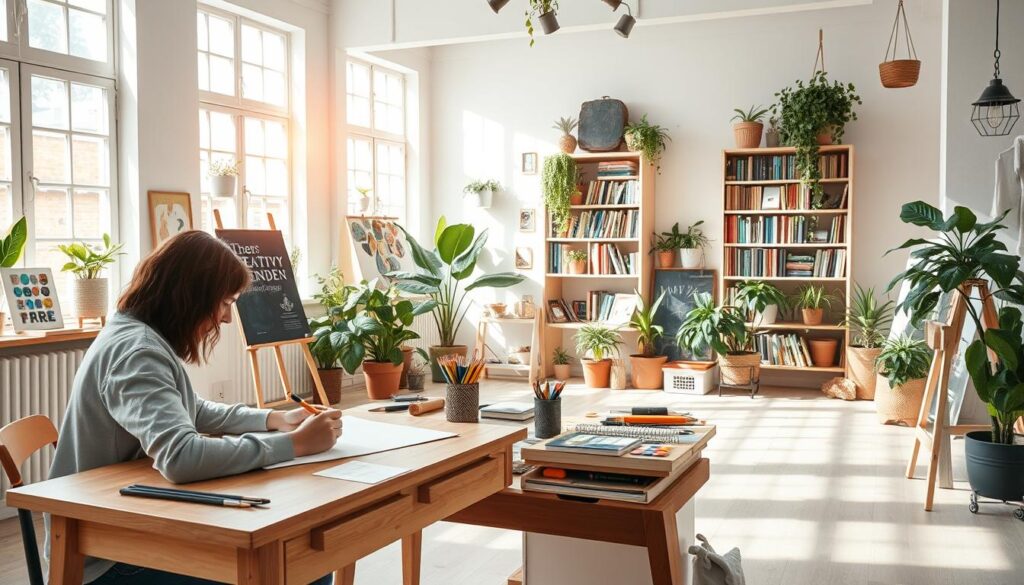
By making creativity a daily priority, you can open up to new ideas and perspectives. This can lead to a more fulfilling life.
Overcoming Creative Blocks
Breaking through creative blocks needs a mix of knowing why they happen and using smart strategies. We’ve all hit that wall, whether it’s when writing, painting, or coming up with new ideas. The bright side is, there are ways to get past these blocks and spark our creativity again.
Identifying Triggers
The first step is to figure out what’s causing the block. Triggers can be things outside of us like stress or distractions, or things inside like fear of failure or wanting to be perfect. Knowing what’s stopping us lets us find ways to get past it.
Think about your current project or task. Are you feeling too overwhelmed? Are there specific parts that are hard for you? Writing down your thoughts or talking to a friend can help find the real reason for your block.
Techniques to Rekindle Creativity
After finding the triggers, it’s time to use some methods to spark your creativity. One good way is to change your environment. A new place or rearranging your space can spark your imagination and give you a fresh view.
Another method is to take a break and do something different. This could be as easy as going for a walk, doing yoga, or reading something not related to your project. Stepping away can clear your mind and give you energy to come back to your task.
Also, working with others can really help. Sharing ideas or working on a project together can bring in new views and spark creativity.
Lastly, seeing failure as a chance to learn can ease the stress of creating. Remember, every big success has had many tries and rejections before it was done.
Collaborating with Others
Working with others boosts our creativity. It creates a space where ideas grow. We share our creativity and learn from each other’s genius.
When starting creative projects, surround yourself with people who inspire you. This could be friends, family, or coworkers who love creativity. A supportive group helps us face challenges and reach our goals.
Building a Supportive Creative Community
A supportive community is key for our growth. It’s a place to share ideas, get feedback, and learn. It’s about a network that gets the ups and downs of creativity.
To create this community, join workshops, online forums, or local groups. Talk and share your experiences. This builds strong bonds and supports each other’s creativity.
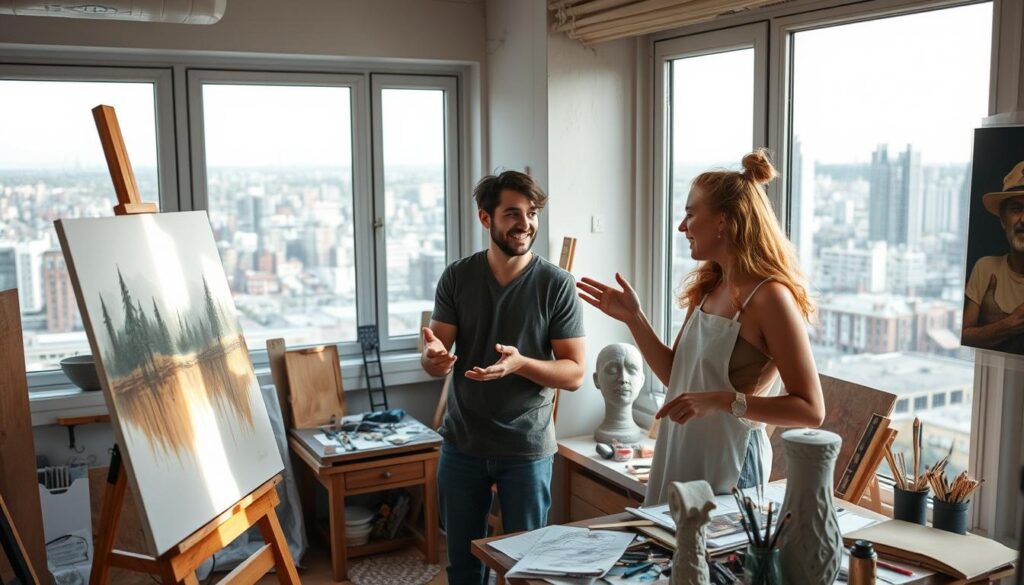
“The most important thing you can do is to create a creative environment. You can be creative anywhere, but if you want to be creative consistently, you need to have a place that supports that.”
This quote highlights the value of a supportive community for creativity.
Benefits of Team Projects
Team projects bring many benefits. They allow us to combine our skills for better solutions. Together, we can solve complex problems and find creative breakthroughs.
- Enhanced creative problem-solving through diverse perspectives
- Increased originality as different ideas and approaches are combined
- Improved ideation as team members build upon each other’s concepts
Collaboration and a supportive community unlock our creativity. Working together on projects, we create outstanding work and a culture of innovation.
Celebrating Your Creative Wins
As we nurture our creativity, it’s key to celebrate our wins, no matter how small. Acknowledging our achievements boosts our confidence and keeps us motivated. It encourages us to keep exploring and pushing the limits of design thinking and artistic expression.
Recognizing our successes makes us feel proud and validates our hard work. This is vital for keeping our creative journey positive and productive.
Achievement Journaling
Keeping a journal of our achievements is a great way to celebrate. Writing down our successes helps us see how far we’ve come. It also shows us patterns in our creative process.
This journal is a valuable tool for tracking our growth over time.
Sharing with Others
Sharing our achievements with friends and family is also meaningful. It lets us inspire others and get feedback and support. This is invaluable in our creative journey.
| Methods of Celebration | Benefits | Outcomes |
|---|---|---|
| Keeping an Achievement Journal | Reflects on progress, identifies patterns | Tracks growth, boosts confidence |
| Sharing with Friends and Family | Inspires others, invites feedback | Receives support, gains new insights |
| Celebrating Milestones | Reinforces motivation, acknowledges effort | Encourages continued creativity, fosters resilience |
Celebrating our creative wins boosts our confidence and passion for art. By making this a part of our routine, we stay positive and inspired in our work.
Lifelong Learning and Creativity
Learning for life is key to keeping our creativity alive. By always looking for new knowledge, we stay inspired. This helps us think outside the box.
Expanding Knowledge through Workshops and Seminars
Workshops and seminars let us learn from the best and meet others who share our interests. They can spark new ideas. This keeps our creativity and imagination sharp.
The Power of Reading and Research
Reading and research are at the heart of lifelong learning. Books, articles, and online resources on Amazon can open our eyes to new things. By reading and researching, we dive deeper into what we love. This leads to more creative ideas.
With a lifelong learning mindset, we keep growing creatively. We stay inspired, nurturing our imagination and creativity.
FAQ
How can I create a space that fosters creativity and supports my best habits?
To make a space that boosts creativity, add natural light and comfy furniture. Plants can also help. Keeping your area tidy helps spark new ideas.
What role does environment play in fostering creativity?
Your environment is key to creativity. A neat, well-designed space sparks your imagination. But, a messy or uncomfortable area can block your creativity. Digital tools can also aid your creative process.
How can I overcome creative blocks and stay inspired?
To beat creative blocks, find out what’s stopping you. Try the Pomodoro Technique to get your spark back. Working with others, going to workshops, and learning new things can also help.
What are some ways to prioritize creativity and make it a part of my daily routine?
To make creativity a daily habit, schedule creative time. Set a routine and use digital tools to help. Keeping a journal and sharing your work can keep you motivated.
How can I leverage technology to enhance my creativity?
Technology can boost your creativity with digital tools and resources. Creative software and online courses offer new ideas and insights.
What are some benefits of collaborating with others on creative projects?
Working with others brings new ideas and skills. This leads to better creative solutions. A supportive community also keeps you inspired and motivated.
How can I maintain and enhance my creativity over time?
To keep creativity alive, always be learning. Attend workshops and read new topics. Celebrating your wins and sharing them can also keep you inspired.
Transform your home into a more peaceful and mindful sanctuary. Creating a Zen-inspired home environment is a core part of the “Live.Learn.Create” theme, focusing on peace, mindfulness, and a clutter-free space. Here is a curated list of Zen home items.
The Zen Essentials
These items are the building blocks of a calm, intentional living space.
- Candles & Scents:
- Scented Candles: Look for calming, natural scents like sandalwood, lavender, white tea, or bergamot. Choose candles made with soy or beeswax for a clean burn.
- Essential Oil Diffusers: A minimalist, sleek diffuser made of bamboo, ceramic, or glass.
- Essential Oil Sets: Look for blends specifically for relaxation, focus, or sleep.
- Incense & Burners: Natural incense sticks (e.g., palo santo, sage) with a simple, elegant burner.
The Zen Decor
This is about incorporating natural elements and simple design.
- Natural Materials:
- Wood or Bamboo Trays: For organizing candles, stones, or other small items.
- Ceramic Vases: Simple, unglazed ceramic vases in neutral colors like white, beige, or gray.
- Minimalist Art: Simple line drawings, abstract prints, or nature-inspired artwork.
- Hand-Carved Stone Coasters: Or other small stone sculptures.
- Textiles:
- Linen or Cotton Throws: A soft, neutral-colored throw blanket to add warmth.
- Jute or Sisal Rugs: These add natural texture and grounding to a space.
- Meditation Cushions (Zafu) & Mats (Zabuton): These provide comfort for meditation and add a serene touch to a room.
The Zen Ambiance
These items help create a peaceful sensory experience.
- Lighting:
- Himalayan Salt Lamps: These provide a warm, soft glow.
- Japanese-style Paper Lanterns: For a soft, diffused light source.
- Dimmable Smart Bulbs: To easily control the warmth and brightness of your lighting.
- Sound:
- Tabletop Water Fountains: The gentle sound of running water is incredibly calming.
- Wind Chimes: Made from natural materials like bamboo or metal for a soft sound.
- Bluetooth Speakers: Small, aesthetically pleasing speakers for playing ambient or meditation music.
- Nature:
- Bonsai Trees or Air Plants: Low-maintenance indoor plants that bring life and a touch of nature indoors.
- Zen Gardens: A small, tabletop sand garden with a rake and stones for a meditative ritual.
- Decorative Rocks & Pebbles: For bowls or as a decorative element.
Best Sellers https://amzn.to/3Vet1tI
New Releases https://amzn.to/4mwLjTi
Amazon Movers & Shakers https://amzn.to/4fPsZlP
Mindfulness Coloring Books https://amzn.to/4fQ0wMx
Personal Growth Coloring Books https://amzn.to/4lJeRf0
Health & Wellness https://amzn.to/4oRt24C
Zen Home Decor https://amzn.to/3VeA3i6
Zen Garden Decor https://amzn.to/4mXjT8D
Zen Garden https://amzn.to/3HQTVVB
- Mindfulness & Meditation:
- Physical Wellness:
- Habit & Productivity Tools:
- Books:
- Best-selling personal development books (Mindset, The 7 Habits of Highly Effective People, The Subtle Art of Not Giving a F*ck)
- Books on a variety of skills (coding, photography, writing.)
- Educational Gadgets:
- Smart pens that digitize notes (e.g., Rocketbook)
- Portable scanners for digitizing documents
- Laptops, tablets, and accessories
Create (Creativity, Innovation, Projects)
These products cater to your creative side, whether you are a artists, writer, or DIY enthusiasts.
- Creative Supplies:
- Adult coloring books or “paint-by-sticker” books
- Craft kits (e.g., candle-making, pottery, embroidery)
- Digital Creation Tools:
- General Inspiration & Making:

